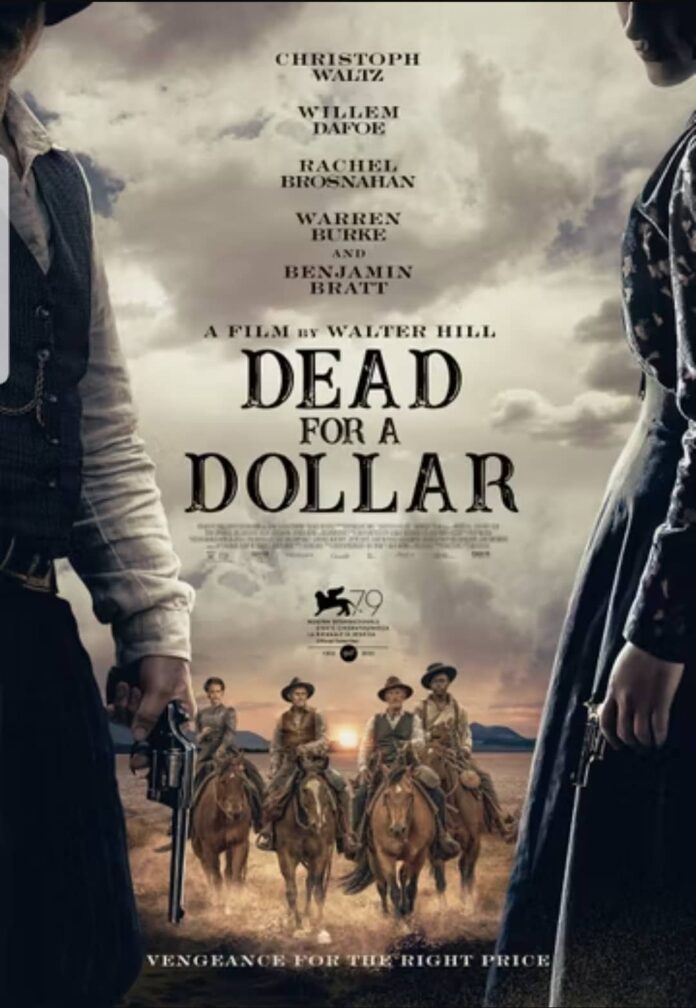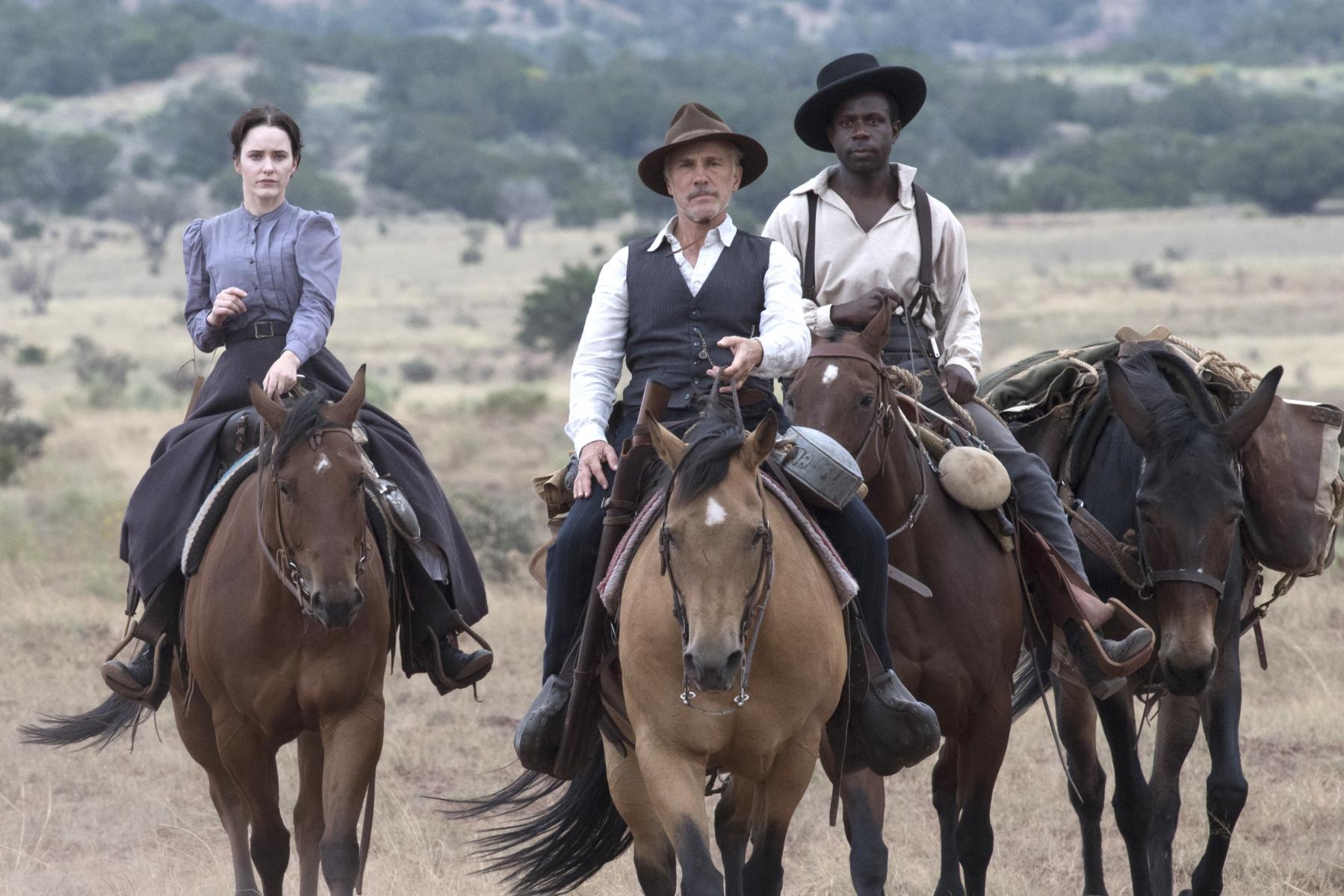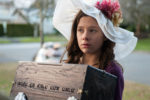[Leer la versión de este artículo en español]
“Walter was one of my biggest heroes growing up. I had only read two scripts and they were so effing dry. But, when I read ‘Hard Times’, it was just description. It wasn’t just a blue print for how to do the movie. I was supposed to make the movie in my mind. When the script was over and I put it down, I saw the movie.”
Quentin Tarantino
January 21, 2020
15th edition of the Final Draft Awards
Reception Speech Quote
of the Final Draft Hall of Fame Award to Quentin Tarantino
Paramount Theatre, Hollywood, California,
Award delivered by Walter Hill
SYNOPSIS
«Dead For a Dollar honors traditional westerns while simultaneously dealing with issues of race relations and the modern empowerment of women.»
Walter Hill. January 2022
Desert landscape. Two figures advance on horseback under the implacable sun. A black man and a white woman, each one on a horse. The woman covers herself under an umbrella.
Albuquerque, New Mexico. June 1897. Bounty hunter Max Borlund (Christophe Waltz) checks into a hotel in the middle of the night. The camera remains outside. There is a shooting of seconds. The flashes of the shots illuminate the darkness of the night and the place in bursts. Nothing to see. Full day. Borlund goes to the New Mexico Territorial Prison. He asks about outlaw Joe Cribbens (Willem Dafoe), to warning him that, when he’ll be released, he stays clear from him. The feeling is mutual. Warnings intersects. The inmate just wants to «go down» to Mexico to play cards, have fun, and see a few «señoritas». Just enjoy his freedom and get away from problems. They both talk about Frank, the man the hunter shot the night before. Joe didn’t know him, but he put on his side -the enemy of my enemy is my friend-. Joe uses the expression “another fella dead for a dollar”. Another death of a man at the hands of a professional of death. The word “dollar” constitutes, in the context, a generic reference to money.
October 1897. A secret meeting takes place in the desert of New Mexico. Borlund arrives. A US Army regiment of colored soldiers, is on duty, with the horses. Captain Orville Brand (Herman Johansen), seated in a chair, is the host of the encounter. The meeting is defined as «in the middle of nowhere» and that «has not taken place.» The captain leaves some privacy to the participants, after introducing Nathan Price (Hamish Linklater), as «a good friend of the army.» He is the husband of Rachel Price (Rachel Brosnahan). The businessman wants to recover his wife who, according to him, has been kidnapped by Elijah Jones (Brandon Scott), a colored soldier who is a deserter. The businessman has been asked for $10,000 ransom, but is not willing to pay. He doesn’t reward outlaws. However, he offers to pay the bounty hunter $2,000, $500 up front, to bring his wife. The hunter accepts. He is given a safe-conduct document so he’ll be going down to Mexico as an official mission. Alonzo Poe (Warren Burke), another young black soldier, who has a certain sympathy for Elijah, is assigned to Max. Poe doesn’t think Jones is capable of kidnapping anyone. Max is also given a portrait of the young woman. The husband reminds him that the woman’s reputation is on jeopardy, but also his, since he wants to embark on a political career.
Max observes the portrait of the young woman and pronounces a literary phrase «Is this the woman who launched 1000 ships into the sea?» referring to Helen of Troy, namely the poem of Shakespeare or Marlowe, as he tells Poe. Quite appropriate verse, not only in a filmography like Hill’s, prone to references to the ancient Greek world. There is Xenophon and his Anabasis, the narrative backbone of The Warriors (USA, 1979), or the epic poem Cowboy Illiad, inspired in its structure by Virgil’s poem. It is also that the character of Rachel does not hide her similarities with the young Trojan female, apparently kidnapped by his lover Paris (here Elijah), but wanted to escape from her husband Menelaus (Nathan in Hill‘s film), and whose rescue was the pretext to unleash the Trojan War. Here just a final reckoning.
Poe is in possession of a rudimentary but revealing map provided by Jones himself. So, the soldier accurately knows where Jones is hiding with Mrs. Price.
The action moves to Roca Roja, State of Chihuahua, Mexico. Rachel and the deserter run away together. They have teamed up with a plump thug named Jack Hannon (Jackamoe Buzzell). Enter Esteban Romero (Luis Chávez), a legal counselor who studied at Monterrey Law School 10 years ago, thanks to Tiberio Vargas (Benjamin Bratt), his client. Hannon owes thousands of dollars in gambling debts to Vargas. He has offered $5,000 of the $10,000 ransom demanded from Mr. Price, on account of that debt. Rachel and Elijah would just keep $5,000, but with the guarantee of being able to travel safely to Veracruz and then to Cuba and escape from Nathan Price’s area of influence, and from the justice of the country. An adjustment takes place, after a certain attempt of «justification» by Jack Hannon of that betrayal of Rachel and Elijah, arguments that go through insulting the woman. Far from being intimidated, she approaches the man, guarantees him that she is not a whore, not without slapping him hard. When the criminal instinctively makes a reactive gesture, the young African American makes it clear that the gesture is not going to materialize at all … pointing him with his revolver.
Tiberio Vargas and his henchmen, including the legal advisor Esteban Romero, have a causal encounter with Max and Alonzo in the middle of the desert. Among Vargas’s men, there is also an Englishman, whom they call English Bill (Guy Burnet). After a few solemn and courteous words, both in Spanish and English, where Vargas intends to charge them for the water used by them and their horses, Borlund stablishes clearly that it’s not gonna happen. He tells them that they are just passing through, on a mission from the US Government. He replies: in Mexico “Los gringos no están al mando”, “en México Tiberio Vargas está al mando”. They all show their weapons. Poe covers Max from the horses with his Winchester. At the same time, with his revolver in his left hand, keeping the rifle with his right, he frightens away Jack Tyree (Scott Peat), one of Vargas’s thugs. As he points the pistol at him, while states “I’m the fella with the gun”. Borlund will ask the Aztec landowner: How is it gonna be? How do you want to play? Vargas and his men leave, but warning them that if they are looking for gold, they must share it with Vargas. It is not the case.
Guadalupe town, Mexico. Joe Cribbens arrives with his intention of playing cards and staying in a hotel. He plays poker too well. Among the players at the table is English Bill, who doesn’t deal with losing hand after hand. He warns that he is not willing to be the target of any plunder with gambling cheats. The ex-con wins cleanly. The Englishman doesn’t have a weapon. Expressing his anger, he left the table. He will come back provided with a revolver. He will be shot down by the ex-con, in a self-defense case.
The bounty hunter and his companion arrive at the cabin shared by Rachel, Elijah and Hannon, thanks to the aforementioned map. The targets are the first two, but the one who gets nervous is the big fella, who believes they are going to kill him. He takes the woman as a hostage. Max takes down Jack Hannon, despite his proximity to Rachel. The young woman asks if he is that confident on his marksmanship. The bounty hunter answers in the affirmative. The woman asks him if he lives under an honor code. The man replies that of course. Honor and decisions about what’s correct, according to their own codes of conduct, mark the path for men like him. When the woman digs into whether the man has been married, he shields himself and decides to end the conversation.
The woman makes clear to her hypothetical rescuer that she doesn’t want to return to her husband, who has mistreated and humiliated her since the beginning of marriage. In the movie The Professionals (USA, 1966), by Richard Brooks, Fardan (Lee Marvin) and Dolworth (Burt Lancaster) discover at some point that the young María (Claudia Cardinale) has never been kidnapped by Raza (Jack Palance). Conversely, she stands beside mexican leader on free will. So, Maria’s husband, the landowner Mr. Grant (Ralph Bellamy) deceived the four men, when hired them for the supposed rescue. If there are kidnappers, they will be. Same feeling for Max Borlund. Young Rachel doesn’t want to be rescued neither, so she has gone with Elijah willingly as well. Mr. Burlund, are you under the impression that you are rescuing me? says the woman with determined standing. Both, her verbal expressions and body language speak for herself.
Enters Captain Miguel Aragón (Fidel Gómez), Sheriff Magistrate of Trinidad María. There is a covenant between the city and Tiberio Vargas. He reigns over the rest of the territory. True justice, represented by Aragon, tries to watch over the city and its inhabitants. Aragón is a straight man surpassed by certain high-handed acts from Vargas and others, that he does not willing to agree with. At some point, embarrassed with the weakness of one of his men, he tells Max he’s willing to do the right thing in an act of absolute integrity.
Another encounter takes place: Alonzo Poe with Jack Tyree. The two men talk, attack and defend each other, equipped with a whip, that both know how to handle. The fight is very reminiscent of the style of other previous confrontations in the director’s cinema. Michael Paré (Tom Cody) and Willem Dafoe (Raven), each provided with a mallet, in one of the final segments of Streets of Fire (USA, 1984); the fight between Bonomo (Sylvester Stallone) and Keagan (Jason Momoa), each one armed with a peak, also in the final part of Bullet to the Head (USA, 2012).
Borlund telegraphs Mr. Price to come to Trinidad Maria. Meanwhile he will try to protect the integrity of Rachel. Nathan Price comes after a few days. The arrival of the American landowner precipitates the final game. The chessboard will witness the movement of the characters that remain standing. Vargas, Nathan, Elijah, Poe, Cribbens, Rachel, and Borlund. The weapons will vomit torrents of fire on the wild landscape of Mexico. Redemption, decision-making to carrying the right thing out, the staunch defense of integrity, announced clash, and the necessary reckoning to reestablish the natural order of things, will take place in a merciless way…not without sacrifices along the way.
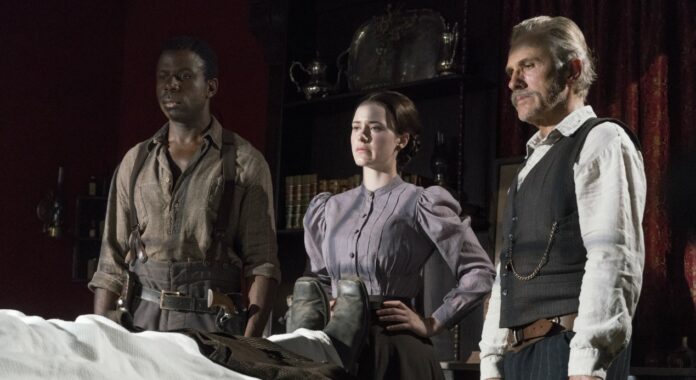
SERGIO LEONE TERRITORY, OR BUDD BOETTICHER’S?
“Budd Boetticher and I were friends, I much admire his movies, and I was finishing this movie, in postproduction, I thought, you know, I think Budd would’ve liked this movie and the reason I think he would’ve liked it, is a kind like he is (laughs) so, I thought… I would… I also get angry that I thing but he is not mentioned enough when people talk about the history of good westerns or great westerns and he when out there with tiny schedules and low budgets, and he made some really terrific films, you know… so as I said,
I was privileged knowing him and he was very friendly with me… “.
Walter Hill. April 6, 2022
Dead For a Dollar Press Conference
79th edition of the Venice International Film Festival
The 21st film directed by Californian director Walter Hill might lead to the self-suggestion and wrong idea that is a surrogate for the Sergio Leone’s Dollar Trilogy. The presence of the word “dollar” in the title, the trailer launched days before the world premiere, oriented to the Venice Film Festival (logo included), with particular efforts to highlight some sound and visual aspects that could remind Leone’s style, (and that do not appear in the images of the film), can induce such consideration. To this particular suggestion towards the Italian ways, would help that the 79th edition of the Venice Film Festival hosted an exhibition in the streets of the center of the Island of Lido Di Venezia dedicated to the composer Ennio Morricone. The exhibition of photos covers the career of the remarkable musician, but there is a manifest preponderance of mentions to Sergio, with striking photographs, images of his films, etc. Furthermore, among the film schedule of the festival, is the documentary film with the pretentious title Sergio Leone- L’Italiano che inventò L’America (Italy, 2022), directed by Francesco Zippel.
All these «trees», in the humble opinion of this reviewer, may not allow «seeing the wood” or “seeing the forest». Dead For a Dollar does not lead us through “Leone territory”, even though the protagonist, Max Borlund, be a bounty hunter, as, for example, the two main characters of For a Few Dollars More (Per Qualche Dollaro in più, Italy, 1965), the man with no name (Clint Eastwood) and Colonel Mortimer (Lee Van Cleef), who seek «Indio» (Gian María Volonté) for revenge besides the reward. The most direct reference to Hill in his first fictional western for the big screen, emerges expressly in the final credits: Dead For a Dollar is dedicated to the memory of Budd Boetticher.

Perhaps all this kind of induction mentioned, made an Italian journalist ask Hill at the press conference on September 6th at 2:30 p.m., about the possible influence of Sergio Leone when filming Dead For a Dollar. The director replied that there are filmmakers who are part of our collective imagination, in such a way that it is impossible not to take them into consideration when filming. He gave some examples: Sam Peckinpah is influenced by Kurosawa. The Japanese director, is it by John Ford. Ford presents certain influence by D.W. Griffith. And finally, Griffith is nourished by the literary tradition of the writer Charles Dickens. Hill looked at the journalist and stood clearly that, in his opinion, Leone belongs to this kind of filmmakers whose cinema is universal heritage and is an inseparable part of our collective imagination.
Being honest, you just have to compare any of the duels made up on Sergio Leone‘s westerns, filmed in the most grandiloquent way possible, and in contrast those of Dead For a Dollar, which are quite the opposite, solved as fast as the blink of an eye. The conclusion is the separate ways of doing things by Hill with regard to Leone.
Budd Boetticher was, along with filmmakers such as Anthony Mann, Samuel Fuller, Don Siegel, Nicholas Ray or Robert Aldrich, who took the genre outside a “comfort area” back in the 1950s, and installed it on the threshold of the violence that would come, on late 60’s with the fall of the big studios system, the derogation of the Hays Code of Censorship, and with the appearance of the «New Hollywood«, anticipating all of it, on a certain way. Specifically, the director of The Man from The Alamo (USA, 1953), used the stoic actor Randolph Scott, with his stony face, like sculpted, in 7 westerns, and made him the epicenter of his way of understanding western genre. These films are movies of revenge, bounty hunters, certain male camaraderie, characters with principles, facing villains (some of them even charismatics) who don’t mind killing women and children, eager for taking easy money. These films contain dry, laconic and witty dialogues (special mention for the five written by Burt Kennedy). They are, films of itineraries, rides, ambushes, assaults, runaway stagecoaches, action scenes solved with great physically efforts, provided with an enormous load of violence and suggestive eroticism (as they were small films, the studios barely noticed them and left do). The explosion of certain barbarism reverberates from the past of the characters, or manifests itself outside the frame, straight to the audience imagination, but suggested with such skills that produces a severe impact, with the minimum expression. 75-minute westerns, very straight, without any frills, that solve the conflict that the film outlines in just a few shots.
Thus, in Ride Lonesome (USA, 1959), Ben Brigade (Scott), was a bounty hunter seeking revenge for the ruthless hanging of his wife years ago by Frank (Lee Van Cleef), brother of young Billy John (James Best). The execution took place in a nude tree, bare of vegetation, robust, parched, lifeless, with solid and twisted branches, capable of carrying a swinging body while life fades away. The perfect place to trend a rope. That tree is on the road to the city of Santa Cruz. Brigade drives Billy John to that city to bring him to justice (is accused by murder). Young Billy John is not Ben’s main target. The bounty hunter knows for a fact that Frank will ride to free his brother. Everyone knows where the final confrontation between Brigade and Frank is going to be.
In Seven Men From Now (USA, 1956), Scott is Ben Stride, a former Sheriff, now bounty hunter, looking for seven dangerous men who have stolen $20,000 from the office of Wells Fargo, one of the most important banking entities in the US. In the execution of the robbery, the outlaws have murdered the female employee of the office. Stride also has a score to settle with them. The sequence where Masters (Lee Marvin) reports Mrs. Greer (Gail Russell) is an example of the solidity of the script of this film, and its relationship with the laconicism of Walter Hill’s films.
– Masters (whit his cot in the hands): Silver Express office was held up. Fargo box was stolen.
Lot of shooting. Somebody was bound to get hurt.
Just too bad it had to be her.
– Anne Greer: Her?
– Masters: Yeah, they killed her. The Sheriff’s wife.
The announced duel between Borlund and Cribbens, the two leading male characters in Hill’s film, materializes in a few seconds, bluntly, without slow motion, without delays, interruptions, change of camera angle, or color. In the same way as the announced final confrontation between Stride and Masters in the aforementioned Seven Men From Now. Both characters have a similar relationship to Hill’s. The two are on opposite sides of the law. One (Stride and Burlund) locked the other (Master and Cribbens) in prison for a long time in the past. Both are destined to be opponent sooner or later.
Continuing comparison between Boetticher and Hill, let us think of a film by one and the other. The character played by Randolph Scott in Comanche Station (USA, 1960), is called Jefferson Cody. He is a “Comanchero”, a man who deals with the Indians. He sometimes negotiates the ransom of people who have been kidnapped by the Comanches. At the beginning of the film, Cody frees Nancy Lowe (Nancy Gates), who has been kidnapped and taken away from her husband and young son. The husband is offering a $5,000 reward. Cody, who ended up disillusioned with the army, rescues the woman and deliver her to the husband, despite a certain emotional flame between he and Nancy. Does Brigade have any interest in the $5,000 being offered? Or is he acting out of pure altruism? Actually her wife was also abducted by the Indians and he travels through the territory, trying to rescue her, when he really knows, at that point, she must be dead already.
The hero of Streets of Fire (USA, 1984) is called Tom, but his last name is Cody. He has been in the army where he liked to shoot, but he never got any medal. Cody ventures towards the hostile territory of «The Bombers», to rescue the singer Ellen Aim (Diane Lane), kidnapped by the biker gang led by Raven (Willem Dafoe). Ellen’s boyfriend Billy Fish (Rick Moranis) offers Cody a hefty wad of cash for the singer’s ransom. Also, in Hill’s emblematic film, there is a return trip, and the hero, again, steps aside in order the woman go back with her partner, despite the old love flame has revived between Cody and Aim.
Following the reasoning of influences that Hill established at the press conference, and the connections between filmmakers, it is obvious that the 7 westerns directed by Boetticher, and performed by Randolph Scott, and namely, the style of the director, the inexpressiveness sought by the actor (and by the director), the way of filming the confrontations, the shootings, the dry and direct dialogues, liked it to Leone. The influence of the adventurer filmmaker from Virginia (former matador) can certainly be easily traced in the Italian filmmaker’s westerns. But that’s another essay.
Walter Hill‘s love tribute to the director of The Tall T (USA, 1956), is exposed with the usual forcefulness and terseness, in the quote that precedes this section. Words that constitute a response to one of the questions asked by this reviewer, at the press conference held on the third floor of the Palazzio Di Casino on September 6th.
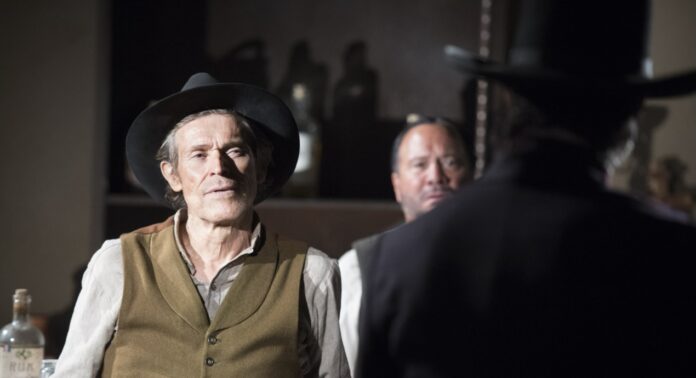
DEAD FOR A DOLLAR WITHIN DIRECTOR’S CAREER AND IN THE CONTEXT OF CURRENT CINEMA
«I’m not even against superheroes. It’s not my cup of tea. But there’s just this endless stream of them and they are so repetitious and suspend certain rules in a way that I don’t find dramatically helpful. The imperviousness can be too much.»
Walter Hill
November 2020
Dead For a Dollar is in the first place, a film with the predominance of sobriety and simplicity. These qualities take on a particular value in a current moment, where cinema has tendency towards the “theme park” idea. Since it is so difficult to drag the audience into a movie theater (home cinema equipment and platforms are making it difficult for the big screen to survive), they think they must give the audience a prolonged show, loaded with «twists» to get the people out of its lethargy, and endow the products with a prefabricated pyrotechnic show of CGI worship. It is necessary to insufflate the commercial film with unstoppable action and shock effects, repeating the key plots over and over again, so that the average viewer can even chat on their mobile while watching the film, without getting too lost. In this sense, some westerns made in the present millennium enter into this dynamic.
For example, 3:10 to Yuma (USA, 2007) by James Mangold, a 140 min. remake, of the 1957’s 90 min. film with same title, directed by Delmer Daves. Furthermore: if we go to the currently thrillers being undertaken in the American filmography, we come across examples that lead us to the conclusion that they are conceived with the same spirit mentioned. Take as an example: Ambulance (USA, 2022), the under average film by Michael Bay. It lasts around two and a half hours! An action thriller, which, if it’d had been filmed in the 80s, would not have passed from 90 minutes. Disadvantages of the conception of cinema in the times of the exhausting hegemony of superheroes, where the most absolute mediocrity seems to have settled…on 2 hours and a half format or more. We are living times where the audience leaves the screening cinema room pretty exhausted, after more than two and a half hours of noise and pyrotechnics and impersonal stuff, that will have been forgotten in less than two weeks.
With Dead For a Dollar, Walter Hill delivers a western with a plot with hardly any twists, which he resolves in just over a tight 100 minutes, with a very small budget and a 25 days shooting schedule on an adorable old fashion way. A concise, straight film that gets to the point quickly. The dilemmas, the decision-making, the applicability of the code of honor under which the characters live, and the confrontations, whether they are with the whip, fists, or firearms, are solved in the blink of an eye, without frills. at the Boetticher or Daves and other Western growers of the 1950s manners. It is in those parameters where the foundations of this vigorous 2022 western must be found. Dead for a Dollar has not aspirations far from it, nor to become part of the prevailing pyrotechnic display. Conversely, Hill sends the audience home quickly, just holding them up, just long enough to tell his story.
The film is being criticized accused of political correctness. The leading role of a prototype of a woman who looks towards the present is clearly evident. Rachel Price (excellent performance by Rachel Brosnahan) is an independent woman, who is not willing to remain under the yoke of her husband, the tyrant Nathan Price, who mistreats her to the point of exhaustion. The young woman, sexually liberated, has a more than unlikely interracial affective relationship with the aforementioned young African-American Elijah Jones. Unlikely we say, just on terms of the time and places where the action takes place, under the strict codes of conduct of those years, and what an interracial relationship would mean for a woman in such puritanical communities. Reference to modernity obliges. The character of Rachel is very well drawn, defined as a woman of character, rebellious and with a great personality. Those characteristics are evidenced in sequences such as the one in which she receives Borlund naked in a bathtub in her hotel room to have a conversation of relevance for the narrative, or where she is able to slap a fierce man out of her face, as has been explained. We can see her strong determination, in the confrontation that takes place in the hotel, where the young woman is armed with her tiny Derringer and a Colt. The character shows complete integrity, on the tradition of Altar Keane (Marlene Dietrich) in Fritz Lang‘s Rancho Notorious, USA, 1952) or Vienna (Joan Crawford) in Johnny Guitar (USA, 1955), directed by Nicholas Ray.
Hill defends himself by saying that Dead For a Dollar could not be anchored in the conception of the western in the 50s, where women, with few tangible exceptions, were relegated to the background and where the attitude of male characters towards female characters is usually of condescension.
However, everything must be said, the women played by Gail Russell, Karen Steele or Maureen O’ Sullivan in Budd Boetticher‘s films are some clear exceptions to the rule. Hill establishes that he had to provide his film with modernity aspects, which encourages new audiences to see the film. Regardless of what fashions force and the reality that films have to be sold, opening the targeting to women and African-Americans, Hill cannot be more honest in the approach. In the final credits of the film where the fate of Rachel Price’s character is explained, it is said that the woman would never get marry again, and she would become a suffragette, that is, a woman devoted to the fight for the right to the vote for women, something they would achieve under Woodrow Wilson’s presidency in 1918. It makes perfect sense that a defined character like Rachel’s ends up in a political cause of authentic commitment like that. It is therefore coherent, and contributes to the realistic design of Rachel as a modern character, and, at the same time, integrating on 1897.
On the other hand, the presence of the two characters, and two actors, African-Americans in the plot of the film, the deserter Elijah Jones and the soldier Alonzo Poe (very well defended by the actors, Brandon Scott and Warren Burke, respectively), is justified in terms of the historical reality of the United States. Since the American Civil War, where it was an exception, the US Army has been using soldiers of color who are even promoted to officer ranks. There are the films Sargeant Ruthledge (USA, 1960), by John Ford, and Glory (USA, 1989), by Edward Zwick, to cover this historical reality, among other examples.
Among the westerns that Hill has directed for the cinema, this is the fourth one as we mentioned. The artist’s favorite genre. All of his films, regardless of the genre they belong to, cannot avoid his gaze towards western genre. It is the first one, as we have already pointed out as well, with fiction characters. Let’s remember that The Long Riders (USA, 1980) focuses on the gang of Jesse James and the Younger brothers; Geronimo: An American Legend (USA, 1993) in the historical Apache leader and namely during the last moments of the Indian wars; Wild Bill (USA, 1994), goes around the figure of James Butler Hickok on the last days of his life, played wonderfully by Jeff Bridges, supported by Ellen Barkin (as Calamity Jane), as well as John Hurt, Bruce Dern, David Arquette, or Diane Lane among others.
We would need to go to his television miniseries Broken Trail (AMC, 2007), starring Robert Duvall and Thomas Hayden Church, to find another fictional western in the career of his director. Concerning Deadwood Series (HBO, three seasons between 2004-2006, and a closing picture on 2019), the pilot episode was directed by Hill, and also revolves around historical figures such as the aforementioned “Bill” Hickok (this time played by Keith Carradine) or Calamity Jane, this time played by Robin Weigert.
Depending on the expectations with which we go to the screening, Dead For a Dollar may or may not disappoint. As a «small» film without big ambitions, is the way you have to approach it, if you want to enjoy. It is not the best western of its director. Neither can we consider by far one of his best films, on a career as a director that began in 1975. However, Dead For a Dollar is a correct and very consistent film, in a film career that is unusual for its coherence along the decades. It is not a film that will go down in terms of crucial films in cinema history, nor will win big prizes. However, a film festival as prestigious as Venice Film Festival, has decided to include it in its program of world premieres. In addition, the main sponsor, the Cartier watch brand, has decided to award Walter Hill a filmmaker award, The Cartier Filmaker, the second awarded, in recognition of his career and his contribution to the evolution of cinema.
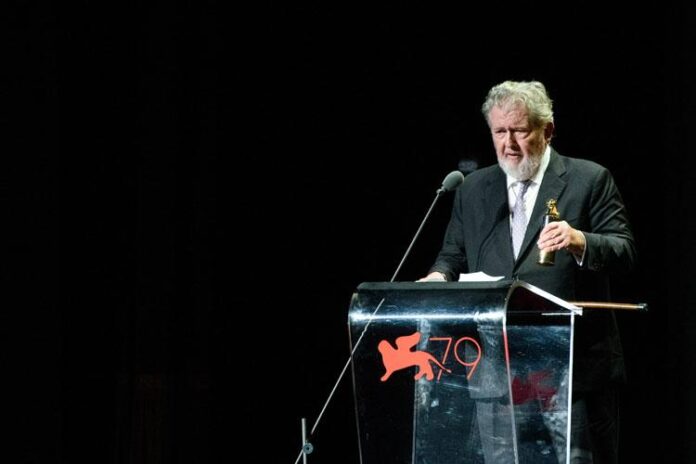
The film has the enormous added value of seeing Willem Dafoe repeat with the Long Beach filmmaker, almost forty years after the aforementioned Streets of Fire. Dafoe plays the juicy character of Joe Cribbens, Borlund’s nemesis, to whom Hill provides one of the astonishing punch lines in the film:
The gunman raises his right hand and says to Esteban, the counselor:
Do you see this, Esteban? (The right hand is raised and extended)
You put a gun in it (it pretends to point at his interlocutor) and it’s the devil’s right hand.
Furthermore, the Austrian actor Christophe Waltz makes a complete show of versatility, since his character has nothing to do with Doctor King Shultz, the bounty hunter he played 10 years ago in Quentin Tarantino‘s western Django Unchained (USA, 2012).
And what can we say about the elegance and poise of Benjamin Bratt as landlord Tiberio Vargas? Or about the cynicism of Hank Linklater wields to performance his sinister character? And about Rachel Brosnahan‘s display of personality in a role-gift? She shares both, vulnerability and fortitude on the same shot.
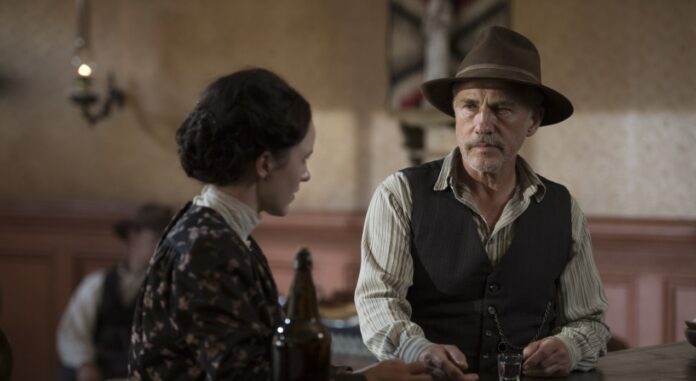
The formidable casting of this film is a clear sign of the presence of an accurate filmmaker behind the camera. A filmmaker who cares a lot about the actors and the direction they take in their images. Let’s take an example: Brewster’s Millions (USA, 1985). We can see Richard Pryor and John Candy, leading the roles. Both actors are usually unleashed in the hands of other directors (grimaces, tics, over acting stuff, etc. are predominant). Under Hill command, Pryor and Candy are not only contained, but they are acting! Even they have such expressive and dramatic registers.
Walter Hill is a filmmaker, that definitely works on the old fashion, but disciplined, way. He focusses on shooting what he needs, how he needs, and he goes away. He loves cinema, from the screenwriting process, to editing phase.
His scripts reveal certain artistic vocation in the use of words. His depictions of the Characters, the years where the action takes place… his expository clarity involves the reader immediately into the filmmaker’s intentions. They are not limited to being mere indicators, they become authentic navigation charts where, after reading, you can already visualize the films, as Quentin Tarantino points out in the quote at the beginning of this review. In this sense, from these pages, we invite you, noble reader, to approach Walter Hill scripts. After post-production, when the film is ready to the world, the films must be able to speak for themselves.
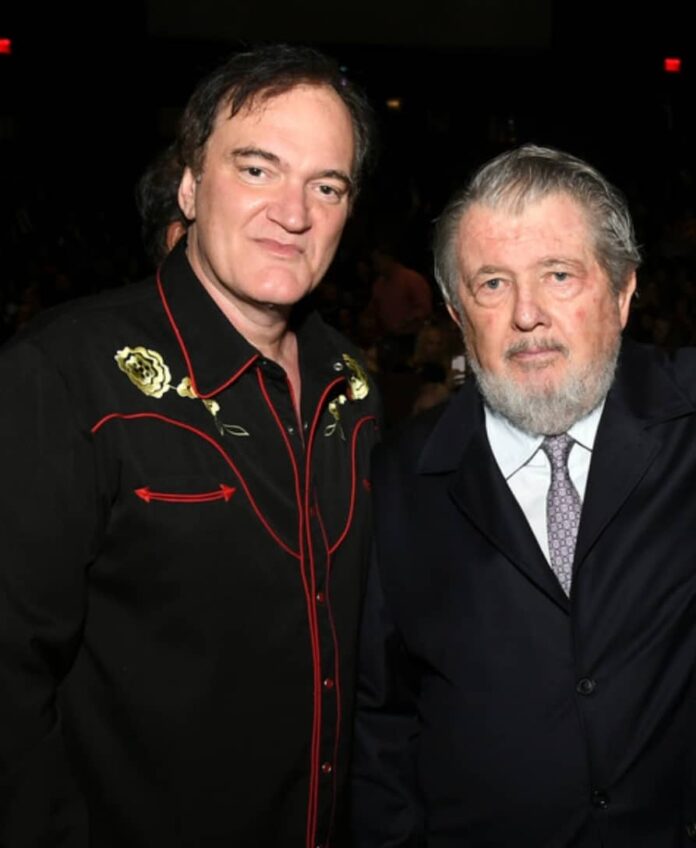
But, in addition, listening to the filmmaker speaking about his films, his intentions about this or that film of his career, about other directors, about the influences, or the interrelationships between the filmmakers, about the collective filmic imaginary, reveals that Walter Hill is quite an intellectual of the cinema. In this sense, Venice Film Festival, will mean rediscovering for the world a filmmaker of great interest. As a film intellectual, Hill is an inseparable member of that generation of filmmakers who changed Hollywood in the 1970s. Filmmakers who were trained in one way or another studying cinema on college or in Studios films programs, but also watching American, European or Asian films. Movies that changed their lives, made them become screenwriters and directors, and in this way, their films, changed also our lives forever.
People talks a lot about the directors of the New Hollywood and that unique generation of film directors who emerged in the 70s of the last 20th century. Critics, historians and cinephiles usually get their mouths full, if you will excuse the expression, talking about Coppola, Lucas, Scorsese, De Palma, Spielberg… but little words are said about those screenwriters who would also have great careers as film directors, and spent years writing or reinforcing scripts for others, who reached some more immediate glory. Hill, along with John Milius and Paul Schrader are some of the most evident examples of this underground but essential trend. Schrader also attended the Venice Biennale 2022. He also received his well-deserved career award. He also came with his most recent film. Many movies of the 70s that we adore today, would not have been the great and inspiring films they are, without the “touch” of these wonderful screenwriters. Three examples will be fair enough: Martin Scorsese‘s Taxi Driver (USA, 1976) written by Paul Schrader), Francis Ford Coppola‘s Apocalypse Now (USA, 1979) (screenplay by John Milius) and Sam Peckinpah‘s The Getaway (USA, 1972) (screenplay by Walter Hill).
Dead For a Dollar is a Western in which Hill has invested heavily. He is also a screenwriter (the story was conceived with Matt Harris). Like Paul Schrader, with his film The Master Gardener (USA, 2022), also premiered at Biennale 79, Hill has been able to face Dead For a Dollar with a great deal of creative freedom, taking into consideration the small parameters in which this film stand. He has summoned Lloyd Ahern II (son of legendary cinematographer Lloyd Ahern Sr.), his cinematographer since Trespass (USA, 1992).
The suggestive soundtrack, which only outlines and sets the action, without underlining or shrillness, has been assigned to the beginner Xander Rodzinski, who has some experience in the musical departments of some important productions. Rodzinski has delivered a beautiful score. The edition of the film has been made by Hill with Phillip Norden. Norden has already been in the editing department as an assistant in some of his films, including the aforementioned Wild Bill, or Last Man Standing (USA, 1996).
The filming took place in Santa Fe, New Mexico, mainly under the production of Myriad Pictures, Cinephile Production and Chaos Film Company Inc. The distribution has been carried out by Quiver Distribution, agreed in some countries such as Italy, with Universal Pictures. The United States opening will take place on September 30th. In Spain the distribution was acquired by A Contracorriente Films.
Summarizing: The reward for the cinephile and western lover of authentic American B-series style, is called Dead for a Dollar. A skillful and entertaining western, without great aspirations, honest with the audience, and with the rules of the genre. If you are a fan of the genre and of its director, you will have what you are looking for. Cinephile justice at the best possible price. A hundred sparkling minutes, well spent in the darkness of a movie theater. In the case of this humble writer, the price has been an unforgettable trip to Venice. Three sessions of this wonderful film at the Lido Di Venezia Island, all of them, on the same day of its world premiere: September 6, 2022. None of the three viewings was uncalled for. Same day of the film’s Press Conference. Same day as the Gala for the delivery of the (deserved) Cartier Filmaker Award to Walter Hill for a lifetime dedicated to the movies.
It has been such an honor and such a privilege being there.
